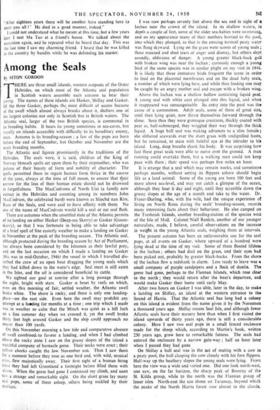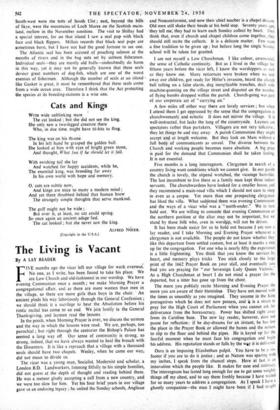Among the Seals
By SETON GORDON
THERE are three small islands, western outposts of the Outer Hebrides, on which most of the Atlantic seal population in Scottish waters assemble each autumn to bear their young. The names of these islands are Hasker, Shillay and Gasker. Of the three Gasker, perhaps the most difficult of access because of the swell which almost always' breaks about it, shelters one of the largest colonies not only in Scottish but in British waters. The Atlantic seal, larger of the two British species, is communal in its breeding habits. It bears its young sometimes in sea-caves, but Irmally on islands accessible with difficulty to its hereditary enemy, man. Autumn is its breeding-season ; a few of the pups are born before the end of September, but October and November are the main breeding months.
The Atlantic seal figures prominently in the traditions of the Hebrides. The seals were, it is said, children of the King of Norway heneath spells set upon them by their stepmother, who was jealous of their beauty of form and nobility of character. The spells permitted them to regain human form thrice in the course of the year, always at the time of full moon, to ensure that tbeir sorrow for the loss of their human estate should not be drowned in forgetfulness. The MacCodrums of North Uist (a family now extinct in the Hebrides and counting among its members John MacCodrum, the celebrated bard) were known as Sliochd nan Ron, Race of the Seals, and were said to .have affinity with them. No one of the name of MacCodrum would kill a seal or eat seal flesh. 1 There are autumns when the unsettled state of the Atlantic permits of no landing on either Hasler (Deep-sea Skerry) or Gasker (Goose- skerry), so that I was fortunate in being able to take advantage of a brief spell of fine easterly weather to make a landing on Gasker in November at the peak of the breeding season., The Atlantic seal, although protected during the breeding season by Act of Parliament, has always been considered by the Islesmen as their lawful prey, and on the last occasion on which I made a landing on Gasker (this was in mid-October, 1946) the vessel in which I travelled dis- turbed the crew of an open boat dragging the young seals which they had killed down to the water's edge. Seal meat is still eaten in the Isles, and the oil is considered beneficial to cattle.
We sighted our goal at sunrise after a long passage through the night, bright with stars. Gasker is beset by reefs on which, even on this morning of fair, settled weather, the Atlantic swell broke white. The shore is rocky, and there is only one landing- place—on the east side. Even here the. swell may prohibit any attempt at-a boding for months at a time ; one trip which I made ' was in weather so calm that the Minch was quiet as a hill loch 1 on a fine summer day when we crossed it, yet the swell broke thirty feet high around Gasker and the ship could approach no nearer than 100 yards. .
On this November morning a low tide and comparative absence of swell combined, to favour a landing, and when I had climbed above the rocky zone I saw on the grassy slopes of the island a watchful company of barnacle geese. Their necks were erect ; their Yellow cheeks caught the low November sun. Thus I saw them for a moment before they rose as one bird and, with wild, musical cries, flew majestically away. Their first sight of a human being since they had left Greenland a fortnight before filled them with alarm. When the geese had gone I continued my climb, and soon saw a strange and remarkable sight. On the short grass lay many seal pups, some of them asleep, others being suckled by their
mothers. .
I was now perhaps seventy feet above the sea and in sight of st lochan near the crown of the island. In its shallow waters, its depth a couple of feet, some of the older sea-babies were swimming, and on my appearance many of their mothers hurried to the pool, into which they plunged, so that in the ensuing turmoil peaty water was flung skyward. Lying on the grass were scores of young seats; these moaned and shed tears of anger and dismay, but others slept soundly, oblivious of danger. A young greater black-back gulf with broken wing was near the lochan; curiously enough a young bird of the same species was in similar plight on my visit in 1946. It is likely that these immature birds frequent the scene in order -to feed on the placental membranes and on the dead baby seals, a number of which were lying here, and while thus feeding one may be caught by an angry mother seal and escape with a broken wing. - Above the lochan was a shallow hollow containing liquid peat. A young seal with white coat plunged into this liquid, and when it reappeared was unrecognisable. Its entry into the pool was the cause of a commotion. Adult seals, some of them of great size, until then lying quiet, now thrust themselves forward through the slime. Seen thus they were grotesque creatures, thickly coated with peat as, half-submerged, they wriggled their way through the thick liquid. A huge bull seal was making advances to a slim female ; she slithered seawards over the short grass with undignified haste, but he remained, to stare with baleful eye at the intruder to his island. Long, deep breaths shook his body. It was surprising how fast these great seals were able to move over the ground. A man running could overtake them, but a walking man could not keep pace with them ; their speed was perhaps five miles an hour.
It is strange that a seal which may remain weeks, and sometimes perhaps months, without setting its flippers ashore should begin life as a land animal. Some of the young are born 100 feet and more above sea-level, and may not catch a glimpse of the ocean, although they hear it day and night, until they scramble down the grassy slopes at the age of a month and take to the water. Dr. Fraser-Darling, who, with his wife, had the unique experience of living on North Rona during the seals' breeding-season, records many interesting facts about their behaviour. He also camped on the Treshnish Islands, another breeding-station of the species west of the Isle of Mull. Colonel Niall Rankin, another of our younger naturalists, made, I believe, careful observations on the increase in weight in the young Atlantic seals, weighing them at intervals.
The present autumn has been an unfavourable one for the seal pups, at all events on Gasker. where upward of a hundred were lying dead at the time of my visit. Some of them floated lifeless in the lochan ; others had died on the grass, and their eyes had been picked out, probably by greater black-backs. From the shore of the lochan flew a redshank in alarm. Less ready to leave was a small company of purple sandpipers and a flock of dunlin. The geese had gone, perhaps to the Flannan Islands, which rose clear to the north ; they would return after the boat's departure, and would make Gasker their home until early May.
After two hours on Gasker I was able, later in the day, to make a landing on Shillay, an island at the western entrance to the Sound of Harris. That the Atlantic seal has long had a colony on this island is evident from the name given it by the Norsemen a thousand years ago. Shillay means Seal Isle,. and although fewer Atlantic seals have their nursery here than when I first visited the island upwards of thirty years ago, there is still a considerable colony. Here I saw two seal pups in a small fenced enclosure made for the sheep which, according to Martin's book, written 250 years ago, grow here to remarkable fatness. The seals had entered the enclosure by a narrow gate-way ; half an hour later when I passed they had gone.
On Shillay a bull seal was in the act of mating with a cow in a peaty pool, the bull clasping the cow closely with his fore flippers. Half-way up the heathery slopes the young seals were lying. From here the view was a wide and varied one. Did one look north-west, one saw, on the far horizon, the sharp peak of Boreray of the St. Kilda group, while to the north was the Flannan group of lesser isles. North-east the sun shone on Taransay, beyond which the peaks of the North Harris forest rose almost to the clouds. South-west were the hills of South Uist ; east, beyond the hills of Skye, were the mountains of Loch Maree on the'Scottish main- land, mellow in the November sunshine. The visit to Shillay had a special interest, for on that island I saw a seal pup with black face and black flippers. Millais records that black seal pups are sometimes born, but I have not had the good fortune to see one.
The Atlantic seal has been accused .of poaching salmon at the mouths of rivers and in the bag nets set by salmon fishermen. Individual seals—they are mostly old bulls—undoubtedly do harm in this way, yet it may not be generally known that these seals devour great numbers of dog-fish, which are one of the worst enemies of fishermen. Although the number of seals at an island ■ like Gasker is great, it must be remembered that these seals come from a wide ocean area. Therefore I think that the Act protecting the species at its breeding-stations is a wise one.















































































 Previous page
Previous page